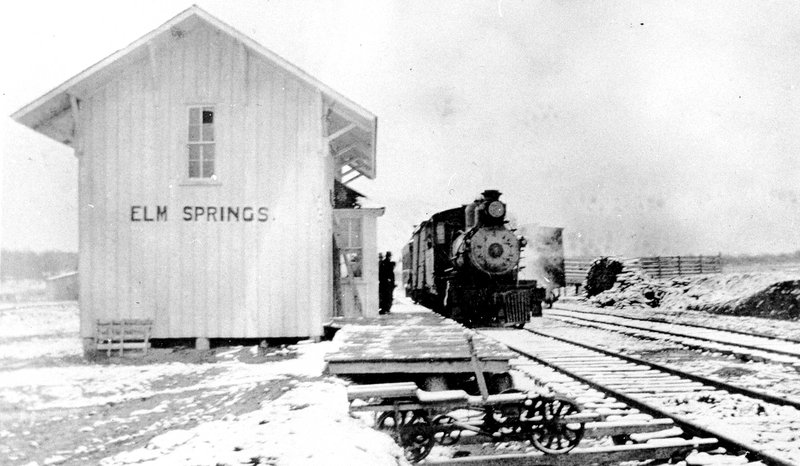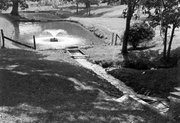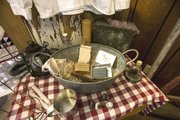Picture Elm Springs: The population nearing 1,800, it was a "sleepy bedroom community" six miles west of Springdale, known as "Ellum Springs" in Ozarks vernacular.
Now imagine Elm Springs with a population of 10,000: Confederate soldiers camped around the springs that gave the town its name.
Historical Society
of Elm Springs
Saturday: Tombstone cleaning workshop, 2 to 4 p.m., Elm Springs Cemetery
April 8: Old movie night fundraiser, 6:30 p.m., Heritage Center. Reservations requested.
April 9: A Country A Fare Marketplace, breakfast and pie fundraiser, 10 a.m to 4 p.m., Steele-Stevens Heritage Park
April 13-16: Elm Springs Heritage Center and Research Library grand opening, 11 a.m. to 4 p.m.
April 15: Dedication of Civil War maker, noon, Steele-Stevens Heritage Park
April 16: Pottery workshop, 1 to 4 p.m., Heritage Center. Cost: $30.
April 18: Learn About Local History, Jewish soldiers’ traditions during Civil War, 6:30 p.m.
April 30: Pottery workshop, 1 to 4 p.m., Heritage Center. Cost: $30.
May 13-14: Pioneer Days, 10 a.m. to 5 p.m., Steele-Stevens Heritage Park
May 14: Dedication of Steele-Stevens Heritage Park, 4 p.m.
May 16: Learn About Local History, presented by Mark Christ, Arkansas Civil War Sesquicentennial Commission, 6:30 to 8:30 p.m.
May 28: Tea and fashion show, 2 to 4 p.m. Cost: $10.
Information: 601-3803
"Tents of the 16th Arkansas Infantry covered the campus of the (school) to the east near the head of Brush Creek during the winter of 1861-1862," reads a historical marker in downtown Elm Springs. "During this period, Dr. M.D. Steele's log house served as headquarters for the infantry unit, and James H. Berry, who later became governor of Arkansas, was a lieutenant in the regiment."
On the same spot, Confederate Maj. Gen. Earl Van Dorn rested his Army of the West at Elm Springs on March 5, 1862, the night before the battle at Pea Ridge. "Early morning found them hurrying to Bentonville," reads the marker.
"It provided a logical point for the Confederates to organize for the coming battle," elaborates an entry on the Arkansas in the Civil War website. "With plenty of water from a cluster of natural springs and plenty of wood for fuel, it was also a good staging point where all of the Southern troops coming down out of the Boston Mountains could gather. It was also within easy striking distance of both Bentonville and the main Federal camps at Sugar Creek near Pea Ridge.
"Considerable snow fell that night," the entry continues. "The snow continued to pile up on the night of the 5th, creating more misery for the freezing men in the Confederate army and more difficulty for the teams trying to bring up their wagon trains of supplies."
And later that year, about 4,000 rebel troops trained at Elm Springs, with some fighting at Cane Hill in November and Prairie Grove in December.
REMEMBERING
That's the history Anita Burney wants folks in Elm Springs to remember, to celebrate. She has organized the Historical Society of Elm Springs -- now open for membership -- and serves as its executive director and president of the board.
Her grandparents lived in Elm Springs while Burney was growing up in California. She and her husband, Gary, moved there when he retired after 40 years as a pastor.
"When Gary and I moved here, I read the historical marker at the end of the street," Burney said. "More than 10,000 Confederate troops were camped around the spring. I'm pushing this on people because they need to understand that history needs to be preserved."
Thanks to the current Elm Springs City Council, the historical society has a headquarters on Water Street, in a 100-year-old building opened in 1915 as the Elm Springs State Bank. Among the historical society's possessions is a 1930s canceled check from the bank, signed by Anita Steele, Burney showed.
This spring, the site of the four springs that gave the town its name will be dedicated by the historical society as the Steele-Stevens Heritage Park. Gene and Glenda Sue Jayroe Stevens of Elm Springs own the land but have secured its eternal conservation and preservation with the Northwest Arkansas Land Trust.
"The land will be preserved in its natural state, and later, its spring headwaters will be nominated to the National Register of Historic Places, while preserving the landscape area with well-maintained grounds, gardens, etc.," reads the historical society's website. This patch of land was at the center of the Confederate camps, Burney said.
Burney's vision is period reenactments and encampments in the park. "I want history to live in 1860s dramas," she said. "It's the perfect fit."
Back at the society's headquarters, Elizabeth Smith works to design the society's museum and research center, which opens next month. A work in progress, the collection currently includes items from various eras of history, although not necessarily tied to Elm Springs. One room and several mannequins are devoted to period costumes designed by Smith.
The museum also received a donation of about 200 reference books about the Civil War and binders of history about the Downum family, long established in the community. Mike Freels, a member of the historical society's board and a genealogist, will volunteer one day a week to assist others in researching their families or the Civil War.
But even before the museum and park see their first visitors, the Elm Springs Historical Society offers events like silent movie nights, speakers about history, pottery and herb gardening workshops, teas and fashion shows, farmers' markets and more as fundraisers.
"The oral history told us this building was used to show silent movies," Burney said of the heritage center. "We want families to bring their kids to watch silent films, to live the history their grandparents lived, to see what their grandparents did differently for entertainment.
"We have the desire to make Elm Springs into the newest historical tourism destination in Northwest Arkansas," Burney concluded. "I think we'll be able to do that with what's up here."
MILLS TO TRUCKS
Elm Springs was settled by folks "tired of the trek west." Thomas McClain was said to have homesteaded the area as early as 1831, but no land records hold his name, according to the Encyclopedia of Arkansas.
John Ingram filed for land in 1840 and built the town's first grist mill on the springs in 1844. Other early settlers were John Hamilton, Jacob Pearson and William Barrington, the entry continues. Barrington came to town in 1849, opened a store and bought interest in the mill. He also served the town as its first postmaster and is credited with naming the town for the four springs "flowing from under the elm trees."
By 1852, the town included a blacksmith shop, churches and a school.
"The Civil War dealt harshly with Elm Springs, as it did with most communities in Northwest Arkansas," reads a history of Elm Springs by Thomas Rothrock, held in the collections of the Shiloh Museum of Ozark History in Springdale. For two years after the Confederate encampments, "the mills were the objective of both the Federal and Confederate raiding parties. With the destruction of the mills, Elm Springs lost its importance as a center of trade."
But by 1877, Elm Springs was a thriving farming community, raising cotton, tobacco and livestock, reads a column by Bill Williams in the Northwest Arkansas Times, relating correspondents' reports printed during the period in the Fayetteville Democrat.
"The citizens of the Elm Springs community in the 1800s lived a simple life," Williams wrote. "It was tough and they were sometimes whipped by nature, but nevertheless were proud of what they were doing and what they were accomplishing in a growing United States."
The citizens of Elm Springs also had their pick of success in the prospering fruit industry of the early 1900s in Northwest Arkansas. A memory of Helen V. Luke, the teacher at the Elm Springs school in 1928-1929, listed muscadine grapes, many varieties of apples grown surrounding the town and of residents making sauerkraut.
In 1914, John Felker of Rogers built the Kansas City and Memphis Railroad -- complete with depot -- from Cave Springs to Elm Springs to Fayetteville. This branch railroad connected with the Kansas City Southern Railroad out of Siloam Springs to carry fruit to market. The railroad service was discontinued in 1918.
"A lot of fruit and vegetables were bought and moved out of here," Burney said. "But it didn't last very long. Oral histories say the rails were taken up for weapons during (World War II). And we had a stagecoach stop, but information about this is very sketchy."
And one pioneer's work rolled the town on to the modern map. The late Willis D. Shaw started his one-man, one-truck operation nearly 80 years ago in Elm Springs. He began by hauling chicken, then frozen chicken products from Northwest Arkansas to distant markets, but the trucks returned empty. Soon, they returned full, delivering other frozen food products to grocery stores, reads an article from The Springdale News. Now MCT Trucking, the company still operates out of Elm Springs.
NAN Our Town on 03/24/2016




